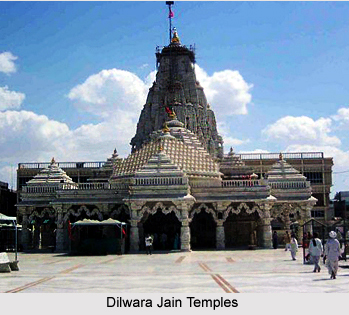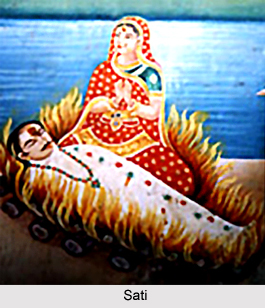 Rajput culture has imbibed lot of customs and traditions from the places they have ruling. The Mughal invasions have had a great impact on Rajput ethnicity. The archaeology, religious beliefs followed, food, amusements all have influences of various sects. According to Hindu Rajput policy Rajputs can only marry amongst other Rajputs. Tradition of marriages into one clan due to caste reasons is not permissible in Islam. This led to a sea change in the traditional marital conventions of Rajputs. Muslim Rajputs started to marry from other high class Muslim clans. Some major Rajput clans of Punjab intermarried into other clans of foreign descent. Rajputs marry outside their clan too. They also try to marry their daughters into clans of higher rank than their own, while accepting daughters-in-law from clans of lower rank.
Rajput culture has imbibed lot of customs and traditions from the places they have ruling. The Mughal invasions have had a great impact on Rajput ethnicity. The archaeology, religious beliefs followed, food, amusements all have influences of various sects. According to Hindu Rajput policy Rajputs can only marry amongst other Rajputs. Tradition of marriages into one clan due to caste reasons is not permissible in Islam. This led to a sea change in the traditional marital conventions of Rajputs. Muslim Rajputs started to marry from other high class Muslim clans. Some major Rajput clans of Punjab intermarried into other clans of foreign descent. Rajputs marry outside their clan too. They also try to marry their daughters into clans of higher rank than their own, while accepting daughters-in-law from clans of lower rank.
It was the Rajputs who kept Hindu culture and art alive throughout the long Muslim rule. The Rajput courts were seats of art and culture. Sanskrit Literature and drama flourished and the different dialects began to exist. The Rajput poets sang praises of their kings in Hindi, the earliest being a ballads known as Prithviraj Raso. Rajput princes were great builders, and constructed magnificent palaces, fortresses, among which the Shaivite temples at Khajuraho in Bundelkhand and the Dilwara Jain temples at Mount Abu are examples of distinct styles. Their paintings reflected the chivalric class and the etiquette associated with it.
From stories it is found that a rice or powdered barley, meat-curry, ghee, and milk comprised the normal diet of wealthy merchants. On festive occasions the attendants drank wine in high amounts. The kings freely indulged in drinking wine in the company of their ministers. In certain events meat or wine is not prohibited. Some kings adopted a very liberal attitude to eating of fish and meat. But majority of Rajputs are vegetarians though that again depends on clan.
Kings of Southern India were fond of jewellery. The kings of Malabar were dressed in cotton loin-cloth and were bare-footed but when he went out on an elephant in procession he wore a golden decorated hat with pearls and gems and golden armlets and anklets.
 The kings wore a necklace made of precious stones, a neck-string, golden bracelets, pearl-anklets and rings on his toes.
The kings wore a necklace made of precious stones, a neck-string, golden bracelets, pearl-anklets and rings on his toes.
The popular amusements of this period were more or less similar to previous ages. Playing with dolls made of wood, ivory or cloth was a favourite pastime for young girls and swings were enjoyed by young married woman.
Drama, dance and singing performances were popular during this period. There has been a mention of musical instruments like stringed instruments, musical horns, drums and lute. The old Indian game of gambling was popular among all sections of people. This game has five varieties.
Wrestling was another favourite pastime which has references. Young wrestlers are fed on special diet at King`s expense. They are given hard training by skilled teachers. While the amusements of the common people were of diverse nature and those of the kings reached a magnificent level. The king after calling upon the experts in wielding weapons would display his skill in using various weapons like sword, spear, bow and others.
Elephant sports and horse sport were the common prevalent games. Displays of fights of birds, beasts and pigeon flights were common. Hunting a boar was familiar. A trained hawk seizes birds on the wing at a height invisible to the naked eye. The king amuses himself by catching carefully fed fish with a rod and line prepared according to specification.
The old beliefs in omens and portents, in astrology, continue to have its firm hold on the people. The belief in omens and portents, in favorable and unfavorable times, in charms and spells for witchcraft was popular. These were followed not only by common man but also by the Kings. The king asks the poets to recite their poems and he decides their merits and defects.
 This custom has references in inscriptions of later Chola kings of Tamilnadu and Karnataka. The king has a number of moguls who were the trusted people of Kings as they are constantly attending him. They burned themselves with their King`s body after his death.
This custom has references in inscriptions of later Chola kings of Tamilnadu and Karnataka. The king has a number of moguls who were the trusted people of Kings as they are constantly attending him. They burned themselves with their King`s body after his death.
The practice of Sati was common during this period. Many women burnt themselves with the bodies of their husbands and this act of sacrifice was praised by all. There are instances of ladies of royal and official families burning themselves after their husband`s death. Actually a widow has to choose between two options, to be precise, live as a widow rest of her life or setting herself ablaze. Generally she would prefer the second substitute as she is likely to be treated badly as long as she lived. The historic fort of Chittor, the seat of the Sisodia kingdom of Mewar, was the site of the three most famous jauhars recorded in history. Self immolation was practiced thoroughly. A custom which was peculiar to the Deccan and South India during this period was that of duel fights.
Another custom is that of a creditor meeting his debtor has to draw a circle upon the ground and make him enter it. Without satisfying his creditor, the debtor cannot leave his circle. The custom of dedicating women Sanskrit Devadasis, Tamil devaradiyar to the temple`s service was prevalent during this period. This custom was considered as a part of the usual establishment of temples.
No Brahmins should allow women who sing, play and dance in their temples. However the kings for his subjects make them a source of attraction so that the expenditure of their armies is met out of the revenues derived there.
A popular custom was to adopt a new name to reflect change of faith in them. Many Rajput kings changed their names, while retaining their ancestral titles. This sense of identity was never been lost and Islam did support and recognize this individuality.
The Rajputs were thought to be naturally martial and aggressive in battle and possess qualities like courage, physical strength, flexibility, loyalty, meticulous, a fighting tenacity, and military strategy. During the British rule they were recruited for service in the colonial army. Rajput ethos emphasizes a martial spirit, with a fierce pride in their lineage and tradition.



















